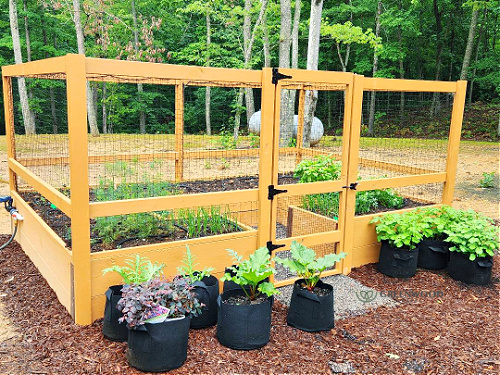Free gardening gloves when you spend $75.00 or more!
Let's talk about how to make gardening easier for those with disabilities, whether they have arthritis, are in a wheelchair or are visually impaired.
Maybe you or someone in your household has difficulty getting around in the garden. These steps can be taken to make it more enjoyable for them.
- Gardening in raised beds and planters. It makes the plants much more accessible to reach. About a 2-3 foot wide raised bed area (wider if access is on both sides) should work for most people and its height should be according to the person gardening in it. For example: a person in a wheelchair would want the height anywhere from 18 to 24 inches tall, while someone with arthritis may want to garden standing and could use a height in the 3 to 4 foot range.
- Use lots of pots or other containers such as window boxes low to the ground. To help reduce the weight, use Styrofoam peanuts in the bottom half of the containers and fill with soil. Anyone can plant everything from seeds, perennials, small shrubs to small trees in containers. For ease in moving the pots, use wheeled caddies which are available at most hardware stores. Locate hanging baskets at lower levels or on benches for easier reach.
- Garden up! Use trellises and other types of plant supporters.
- Walkways should be a minimum of 3 feet wide. Ramps should be out of a non-slippery material and a handrail maybe necessary. There are many possible surface materials for walkways. However, packed soil is one of the cheapest. Of course, it will be muddy during wet weather. Sandstone pavers and brick are also good options but will be more costly. Remember, wood will work, but will be slippery when wet.
- For those visually impaired, choose plants that offer bright colors, variety of textures and lots of fragrance. A wide assortment of perennials and herbs works wonders for the senses. Group large areas of plants according to colors for more impact, as those with only partial visual problems will be able to locate them easier.
- Use sound effectively. Add into the garden chimes, wind mills, fountains, and birdhouses to create soothing sounds.
- Who doesn't like a sandbox? It brings out the child in all of us. Take an old barrel or other container and fill with coarse sand. It will make a great exercise for arthritic hands (or even feet if the barrel is low enough) and a perfect playground for children with physical limitations.
This is my enclosed raised bed garden! So perfect, plus keeps deer and other wild critters out!

For further reading on how to remake a garden to be more accommodating for those with physical disabilities or limitations, check out these books at your local library, bookstore or Amazon.
Accessible Gardening for People with Physical Disabilities: A Guide to Methods, Tools, and Plants by Janeen R. Adil
Accessible Gardening: Tips & Techniques for Seniors & the Disabled by Joann Woy
Related articles for even more ideas!
- Arthritis: From Minor Pain to Disability (everydayhealth.com)
- Managing Symptoms of Arthritis in Your Hands (everydayhealth.com)
- Arthritis Therapies for Body, Mind, and Spirit (everydayhealth.com)
- Olivia gets backyard wish (windsorstar.com)
- Gardens without Borders Open House, July 16 (avantgarden-ht.com)
- Gardening Against the Odds: Horatio Chapple's garden will be a lasting legacy (telegraph.co.uk)
We hope you have enjoyed our article on Garden With Physical Limitations.








